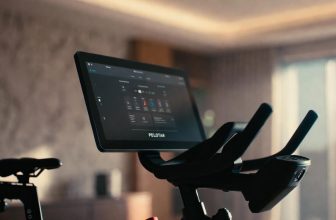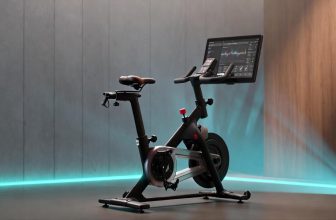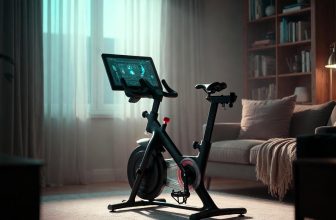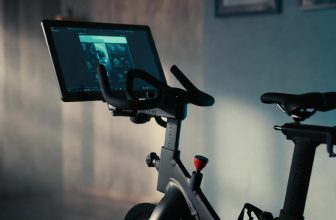Table of Contents
- How Do Exercise Bikes Work?
- Mechanics of Exercise Bikes
- Types of Exercise Bikes and Their Mechanisms
- Spin Bikes
- Upright Bikes
- Recumbent Bikes
- Air Bikes
- Physiological Impact of Exercise Bikes
- Workout Effectiveness and Techniques
- Maintenance for Optimal Performance
- FAQ
- How do exercise bikes burn calories?
- Are recumbent bikes less effective than spin bikes?
- Do air bikes work differently from other bikes?
- How often should I use an exercise bike?
- Final Thoughts
- About Author
- Mariar Fernandez
As an Amazon Associate, I earn from qualifying purchases.
How Do Exercise Bikes Work?
How Do Exercise Bikes Work? Exercise bikes work by providing a low-impact cardiovascular workout through pedaling against adjustable resistance, engaging leg muscles and burning 200–600 calories per 30-minute session, depending on intensity and bike type.
Mechanics of Exercise Bikes
Exercise bikes simulate outdoor cycling using a pedal-driven system connected to a flywheel, which provides resistance to mimic the effort of riding on varied terrain. Resistance is adjustable, allowing users to customize workout intensity. A 2023 study from the American College of Sports Medicine notes that cycling engages major leg muscles—quads, hamstrings, glutes, and calves—while elevating heart rate for cardiovascular benefits. Bikes feature a drivetrain (belt or chain) and braking systems (magnetic, friction, or air) to control resistance, ensuring a smooth, low-impact workout.
- Flywheel: A weighted wheel (5–40 pounds) creates momentum, simulating real cycling.
- Resistance: Magnetic systems are quiet and precise; friction systems are durable but noisier.
- Drivetrain: Belt drives are low-maintenance; chain drives require occasional lubrication.
For more on bike mechanics, see REI’s Guide to Stationary Bikes.
Types of Exercise Bikes and Their Mechanisms
Spin Bikes
Spin bikes use heavy flywheels (30–40 pounds) and friction or magnetic resistance to mimic outdoor cycling. Users can stand or sit, engaging core and leg muscles intensely.
- How They Work: A heavy flywheel and adjustable resistance simulate hill climbs or sprints, burning 315–860 calories in 30 minutes for a 155-pound person, per Harvard Medical School.
- Features: Often include clip-in pedals and handlebars for multiple grip positions.
- Example: Peloton Bike+ – Uses magnetic resistance and auto-adjusting settings for precise workouts.
Upright Bikes
Upright bikes feature a compact design with a lighter flywheel (10–20 pounds), focusing on seated pedaling and moderate resistance.
- How They Work: Engage core and legs, burning 210–465 calories in 30 minutes. Magnetic resistance ensures smooth operation.
- Features: Adjustable seats and handlebars for ergonomic fit, per Hospital for Special Surgery.
- Example: Schwinn IC4 – Offers 100 magnetic resistance levels and app integration.
Learn proper bike setup at Hospital for Special Surgery’s Guide.
Recumbent Bikes
Recumbent bikes have a reclined seat with back support, using a medium flywheel (15–25 pounds) and magnetic resistance for low-impact workouts.
- How They Work: Focus on leg muscles with minimal core engagement, burning 180–390 calories in 30 minutes. Ideal for joint-friendly exercise.
- Features: Step-through frames and padded seats enhance comfort, per the Arthritis Foundation.
- Example: NordicTrack Commercial VR25 – Includes 26 resistance levels and a 14-inch touchscreen.
Air Bikes
Air bikes use a fan as the flywheel, where resistance increases with pedaling speed, engaging both upper and lower body.
- How They Work: Fan resistance scales dynamically, burning up to 700 calories in 30 minutes at high intensity, per a 2024 Journal of Sports Sciences study.
- Features: Dual-action handlebars for full-body workouts.
- Example: Assault AirBike – Combines fan resistance with robust construction.
Physiological Impact of Exercise Bikes
Exercise bikes deliver cardiovascular and muscular benefits by elevating heart rate and engaging lower-body muscles. A 2023 American Heart Association study found cycling reduces heart disease risk by 15%. Bikes also improve aerobic capacity, with a 2024 University of Texas study noting a 10–15% increase in VO2 max after 12 weeks of regular use. Calorie burn varies by intensity:
| Bike Type | Moderate Intensity (Calories/30 min, 155 lbs) | Vigorous Intensity (Calories/30 min, 155 lbs) |
|---|---|---|
| Spin Bike | 390 | 720 |
| Upright Bike | 260 | 390 |
| Recumbent Bike | 220 | 325 |
| Air Bike | 350 | 700 |
For health benefits, see Arthritis Foundation’s Exercise Guide.
Workout Effectiveness and Techniques
Exercise bikes are versatile, supporting various workout styles:
- Steady-State Cardio: Pedal at 60–70% max heart rate for 30–45 minutes, burning 200–400 calories.
- HIIT: Alternate 30 seconds high resistance with 1 minute low resistance for 15–20 minutes, increasing fat burn by 20%, per a 2024 study.
- Interval Training: Mix short bursts of vigorous pedaling (70–85% max heart rate) with recovery periods.
- App-Guided Classes: Use platforms like Peloton or iFIT for motivation. “Classes make workouts feel shorter,” says a Peloton user.
For workout plans, visit American College of Sports Medicine.
Maintenance for Optimal Performance
Proper maintenance ensures exercise bikes function effectively:
- Clean Regularly: Wipe sweat off frames to prevent corrosion.
- Lubricate Drivetrain: Apply lubricant to chain-driven bikes every 6 months, per manufacturer guidelines.
- Check Bolts: Tighten pedals and seats monthly to maintain stability.
- Inspect Resistance: Ensure magnetic or friction systems operate smoothly.
FAQ
How do exercise bikes burn calories?
They engage leg muscles against resistance, elevating heart rate to burn 200–700 calories in 30 minutes, depending on intensity and bike type.
Are recumbent bikes less effective than spin bikes?
Recumbents burn slightly fewer calories (180–390 vs. 315–860) but support longer, joint-friendly sessions, ideal for beginners or seniors.
Do air bikes work differently from other bikes?
Yes, air bikes use fan resistance that scales with effort, engaging upper and lower body for higher calorie burn (up to 700 calories in 30 minutes).
How often should I use an exercise bike?
For fitness benefits, cycle 4–5 times weekly for 30–45 minutes at moderate to vigorous intensity, per CDC guidelines.
Final Thoughts
Exercise bikes work by providing customizable, low-impact workouts through pedal-driven resistance, engaging key muscle groups and boosting cardiovascular health. Spin and air bikes maximize intensity, upright bikes balance space and performance, and recumbents prioritize comfort. Regular maintenance and varied workouts, like HIIT or app-guided classes, enhance effectiveness. Choose a bike based on your fitness goals and space, and stay consistent for optimal results.







